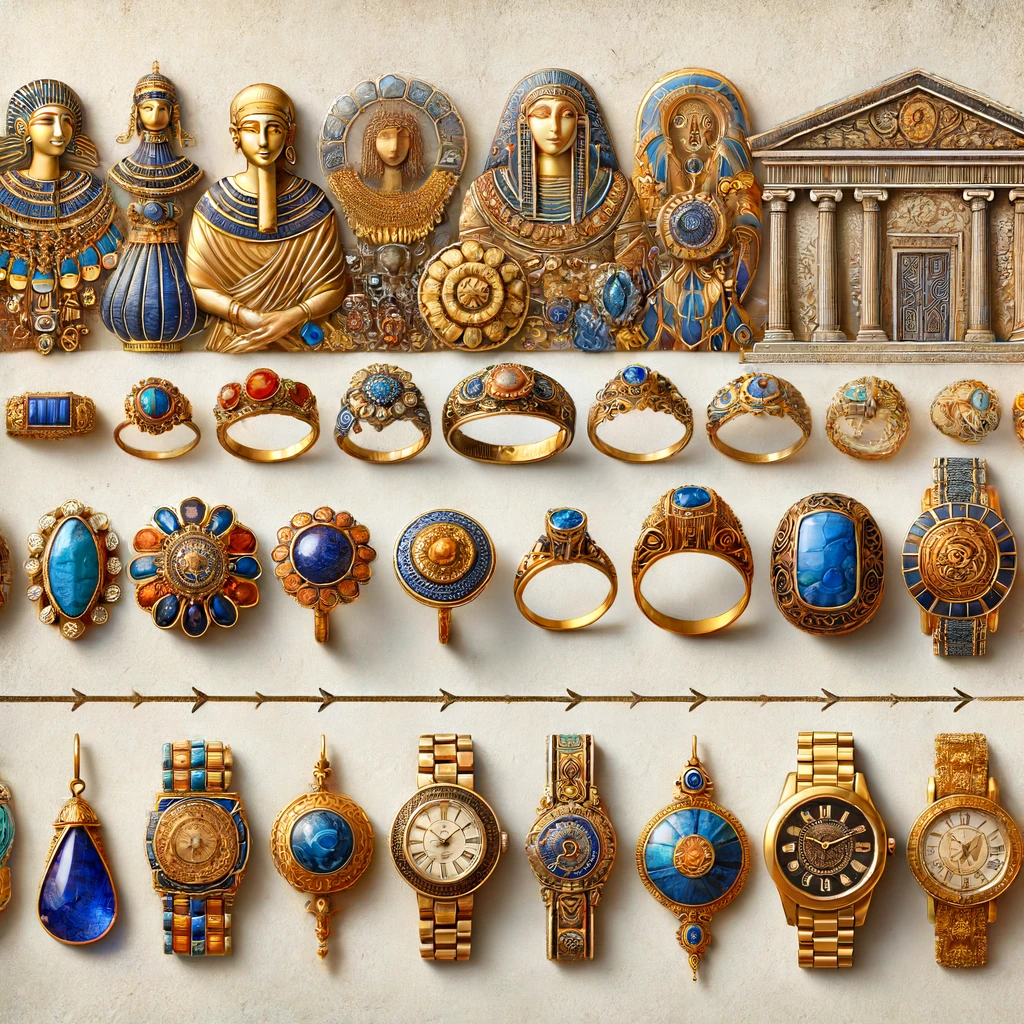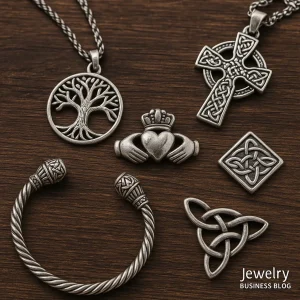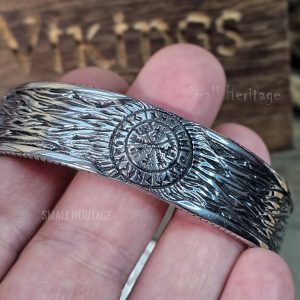Jewelry has always been more than just adornment; it’s a reflection of cultural identity, status, and artistic expression. The evolution of jewelry craftsmanship over millennia showcases the ingenuity and creativity of different civilizations. This comprehensive exploration traces the journey of jewelry making from ancient techniques to modern innovations, highlighting key advancements and enduring traditions.
Ancient Techniques
Egyptian Jewelry Craftsmanship: Techniques and Symbolism
Materials and Symbolism
Ancient Egyptian jewelry, dating back to around 4000 BCE, was not only decorative but also deeply symbolic. Gold, considered the flesh of the gods, was widely used alongside precious stones such as lapis lazuli, turquoise, and carnelian. Each material had specific symbolic meanings: lapis lazuli symbolized the heavens, turquoise represented protection and health, and carnelian was associated with energy and rebirth (ARCE). To dive deeper into the fascinating world of ancient Egyptian jewelry, including its symbolism and craftsmanship, check out our detailed post on Ancient Egyptian Jewelry: Symbolism and Craftsmanship.
Techniques
Egyptian artisans were adept at techniques such as granulation, filigree, and cloisonné. Granulation involved fusing tiny gold beads onto a surface to create intricate patterns. Filigree used delicate threads of gold or silver twisted into lace-like designs. Cloisonné involved filling compartments formed by metal strips with enamel to create colorful designs.
Mesopotamian Jewelry: Craftsmanship and Innovations
Historical Significance
Mesopotamian jewelry, especially from the Sumerian period, is renowned for its detailed craftsmanship. Artisans from this region, dating back to 2600 BCE, used materials such as gold, silver, and a variety of gemstones, including lapis lazuli, agate, and carnelian.
Innovative Techniques
Sumerian jewelers were pioneers in techniques like engraving and inlay. They created intricate designs by engraving metal surfaces and inlaying them with precious stones, resulting in highly detailed and ornate pieces.
Greek and Roman Jewelry: Classical Elegance and Innovations
Greek Jewelry
Greek jewelry, flourishing around 1400 BCE, was characterized by its elegance and use of motifs such as the meander (Greek key) and acanthus leaves. Techniques like casting and repoussé (hammering metal into a mold) were widely used (Encyclopedia Britannica).
Roman Jewelry
Roman jewelers, influenced by Greek techniques, introduced new methods such as cameo carving and the use of colored glass. They perfected the use of gold and gemstones, creating intricate pieces that reflected the wearer’s status and wealth.
Medieval and Renaissance Jewelry Craftsmanship
Byzantine Jewelry: Cultural Synthesis and Techniques
Cultural Synthesis
The Byzantine Empire (330-1453 CE) was a melting pot of cultural influences, reflected in its jewelry. Byzantine jewelers incorporated Roman, Greek, and Eastern styles, creating pieces that were both elaborate and symbolic (World History Encyclopedia).
Techniques
Byzantine artisans excelled in cloisonné enamel and stone setting. They used gold to create intricate designs filled with colorful enamel, often depicting religious scenes and figures.
Gothic and Renaissance Jewelry: Symbolism and Opulence
Medieval Symbolism
During the Gothic period (12th-16th centuries), jewelry became more symbolic, often featuring religious motifs. Techniques like niello (a black mixture of copper, silver, and lead sulphides) were used to create contrast and intricate designs .
Renaissance Jewelry
The Renaissance period saw a revival of classical themes and an emphasis on opulence. Jewelers used new techniques such as faceting gemstones to enhance their brilliance. The use of enameling and the incorporation of portrait miniatures were also popular during this time.
Modern Jewelry Innovations
Industrial Revolution and Mass Production
Technological Advancements
The Industrial Revolution (18th-19th centuries) brought significant changes to jewelry making. The introduction of machinery allowed for mass production, making jewelry more accessible. Techniques such as electroplating and the use of synthetic gemstones revolutionized the industry.
Design Movements
The 19th century saw the rise of design movements such as Art Nouveau and Art Deco. Art Nouveau (1890-1910) emphasized organic forms and natural motifs, with jewelers like René Lalique leading the way in innovative designs using enamel and semi-precious stones. Art Deco (1920-1935) was characterized by geometric shapes and bold colors, reflecting the modernity and exuberance of the time.
Contemporary Jewelry Craftsmanship: High-Tech and Sustainability
High-Tech Techniques
Modern jewelry making incorporates high-tech techniques such as laser cutting and 3D printing. These advancements allow for unprecedented precision and customization, enabling jewelers to create intricate designs that were previously impossible.
Sustainable Practices
Sustainability has become a significant focus in contemporary jewelry making. Techniques such as recycling precious metals and using ethically sourced gemstones are increasingly important. Jewelers are also exploring innovative materials like lab-grown diamonds, which offer a sustainable alternative to mined stones.
Artistic Innovation
Contemporary jewelers continue to push the boundaries of design and craftsmanship. Artists like Wallace Chan have pioneered techniques such as the “Wallace Cut,” a carving method that creates a three-dimensional optical illusion in gemstones. The use of non-traditional materials like titanium and advanced enameling techniques are also prevalent in modern jewelry.
Enduring Traditions and Practical Applications in Jewelry Craftsmanship
Timeless Techniques
Despite technological advancements, many traditional techniques remain in use today. Granulation, filigree, and cloisonné, developed thousands of years ago, are still valued for their intricate beauty and craftsmanship. These techniques are often combined with modern methods to create pieces that honor the past while embracing the future.
Customization and Personalization
Modern consumers increasingly seek personalized jewelry. Techniques such as hand engraving and custom casting allow jewelers to create unique, bespoke pieces that reflect individual tastes and stories. The ability to blend ancient craftsmanship with contemporary innovation provides endless possibilities for customization.
Global Influence
Jewelry craftsmanship has always been influenced by cultural exchanges. Today, globalization allows for a fusion of styles and techniques from around the world. Artisans draw inspiration from diverse traditions, creating jewelry that celebrates global heritage and contemporary aesthetics.
For further exploration of jewelry history and techniques, visit our post on Ancient Egyptian Jewelry: Symbolism and Craftsmanship.
By understanding the history and significance of these techniques, we gain a deeper appreciation for the artistry and cultural heritage that jewelry represents. As we move forward, the fusion of traditional craftsmanship with cutting-edge technology promises to bring even more exciting developments in the world of jewelry.






One Response